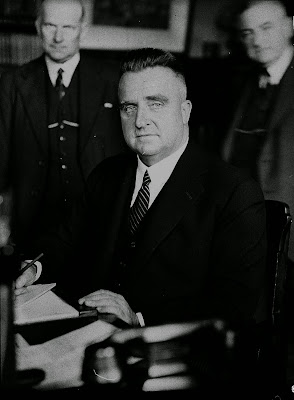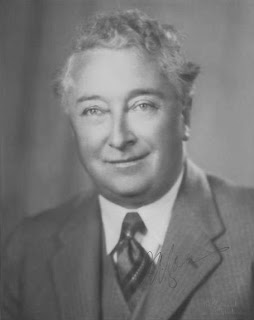GAINING GROUND: NSW Premier Bertram Stevens (photo) tells Michael Bruxner he could have his referendum on self-government, but with decreasing support and continuing disputes over boundaries, Bruxner feared to put the matter to the test, a decision he would come to regret.
In October
1931, the dream of self government for New England
seemed within reach. The various new state movements had combined to form the
United Country Movement with the United Country Party as its political wing,
while all the non-Labor groups had agreed that new states should be a key plank
in their combined platform.
 David
Drummond, the member for Armidale, had played a deciding role in those complex
negotiations.
David
Drummond, the member for Armidale, had played a deciding role in those complex
negotiations.
Unlike
Page, Hardy or (to a lesser extent) Bruxner, Drummond was not a mass agitator. He
had deliberately turned himself into a good stump speaker, perhaps better than
Page or Bruxner in terms of delivery and clarity, but he lacked the emotional
spark that allowed the others to sweep a crowd before them. He was too concerned
to explain, to appeal to the intellect rather than the emotions of his
audience. In a very real sense he wanted to teach his audience just as he had
so painstakingly taught himself.
These
weaknesses were offset by a very major strength, his ability to give form and
coherence to ideas and organisations. He was also trusted. In the chaotic
conditions of the time, it was these strengths that were most needed. Drummond
had played a key role in creating unity among the country movements. Now he would
try to steer the cause through the next stages.
The December 1931 Federal elections saw the first
setback. The unity that had been established among the non-Labor forces was
swept aside in sometimes bitter campaigning, with Joseph Lyons able to
establish a majority United Australia Party government in January 1932
excluding Page and the Country Party.
In NSW, the Governor Sir Philip Game dismissed Jack
Lang on 13 May 1932. Early in 1931, the New England
and Riverina Movement had been prepared to secede. Later, in changing
circumstances, the decision had been reached that they would act if Premier
Lang again breached the constitution.
Page saw Lyons in Melbourne. Lyons told Page quite bluntly that if New
England did secede, he might be forced to call in the army. The
movement temporized. There was still willingness to act, but only in the right
circumstances. Game’s dismissal of Lang ended that option. They had waited too
long, something many would regret.
The NSW
state elections of June 1932 saw Labor swept from power. On 23 August 1933,
Justice H.S. Nicholas was appointed to determine the areas of NSW
suitable for self-government.
After his
earlier experience with his successful move to create the disastrous Cohen
Royal Commission, Drummond was taking no chances. Not only was Nicholas
carefully selected, but Drummond demanded answers in writing from Nicholas over
his scope and role. The question of suitability was out. The only issue was
definition of boundaries.
The first
hearings were held on 18 October 1933, with Drummond organising the various
movement responses. The fervour that had marked 1931 and 1932 was gone.
Opposition emerged, with the position of the powerful Norco
dairy cooperative particularly problematic for it feared the loss of the Sydney milk market.
Nicholas reported in 1935. He found that
two areas would be suitable for self-government as States within the
Commonwealth of Australia, a northern region, and a central, western and
southern region, with descriptions of the boundaries of each region listed.
NSW Premier Bertam Stevens told Bruxner
that he could have his referendum on self-government. With enthusiasm down as
well as continuing disputes over boundaries, Bruxner feared to put the matter
to the test.
Bruxner would come to deeply regret this
decision. But, for the present, the cause had ended. It would be ten years
before agitation re-surfaced.
Note to readers: This post appeared as a column in the Armidale Express Extra on 17 December 2014. I am repeating the columns here with a lag because they are not on line outside subscription. You can see all the Belshaw World and History Revisited columns by clicking here for 2009, here for 2010, here for 2011, here for 2012, here for 2013, here for 2014.
If you want to follow the story of the Northern or New England self-government movement, this is the entry post for the series.

![Nimbin domes73[5] Nimbin domes73[5]](http://lh4.ggpht.com/-tJpTh4pgdaA/VJih2mSR9kI/AAAAAAAAJp4/_vr3Z2jM1g8/Nimbin%252520domes73%25255B5%25255D_thumb%25255B3%25255D.jpg?imgmax=800)












